- collaboration
Invite Team Members
Assign Projects
Users & Role Management
Review Management [Test Cases]
Review Management [Elements]
Execution Controls
- test cases
Test Cases
Test Case List Actions
Import and Export Test Cases
Import Test Project Test Cases
Importing Postman Collections and Environments
Test cases for Desktop Windows
Update Test Case result in a Test Plan
Test cases for Mobile Web Application
- Test Step Types
Type: Natural Language
Type: REST API
Type: Step Group
Type: For Loop
Type: While Loop
Type: Block
Type: If Condition
Nested Step Groups
Create Test Steps
Image Injection
Cross-application testing
- Test Data Types
Raw
Parameter
Runtime
Random
Data Generator
Phone Number
Mail Box
Environment
Concat Test Data
Create Test Data [Parameter]
Update Test Data Profile
Updating Value in TDP
Import TDP
Bulk Deletion of a Test Data Profile
Create Test Data [Environment]
- Elements (Objects)
- Web Applications
Record Multiple Elements
Record Single Element
Create Elements
Supported Locator Types
Formulating Elements
Shadow DOM Elements
Verifying elements in Chrome DevTools
Handling iframe Elements?
Dynamic Locators using Parameter
Dynamic Locators using Runtime
Using Environment Test Data for Dynamic locators
Import/Export Elements
AI Enabled Auto-Healing
- test step recorder
Install Chrome Extension
Install Firefox Extension
Install Edge Extension
Exclude Attributes/Classes
- test plans
Add, Edit, Delete Test Machines
Add, Edit, Delete Test Suites
Schedule Test Plans
Run Test Suites In Parallel
Cross Browser Testing
Distributed Testing
Headless Testing
Test Lab Types
Disabling Test Cases in Test Plans
AfterTest Case
Post Plan Hook
AfterTest Suite
Email Configuration in Test Plan
Execute Partial Test Plans via API
Ad-hoc Run
Test Plan Executions
Dry Runs on Local Devices
Run Tests on Vendor Platforms
Run Test Plans on Local Devices
Test Locally Hosted Applications
Debug Test Case Failures
Parallel and Allowed queues
- debugging
Debug results on local devices (Web applications)
Debug Results on Local Devices
Launch Debugger in the Same Window
- Testsigma Agent
Pre-requisites
Setup: Windows, Mac, Linux
Setup: Android Local Devices
Setting up iOS Local Devices
Update Agent Manually
Update Drivers Manually
Delete Corrupted Agent
Triggering Tests on Local Devices
- troubleshooting
Agent - Startup and Registration Errors
Fetching Agent logs
Upgrade Testsigma Agent Automatically
Testsigma Agent - FAQs
- continuous integration
Test Plan Details
REST API (Generic)
Jenkins
Azure DevOps
AWS DevOps
AWS Lambda
Circle CI
Bamboo CI
Travis CI
CodeShip CI
Shell Script(Generic)
Bitrise CI
GitHub CICD
Bitbucket CICD
GitLab CI/CD
- desired capabilities
Most Common Desired Capabilities
Browser Console Debug Logs
Geolocation Emulation
Bypass Unsafe Download Prompt
Geolocation for Chrome & Firefox
Custom User Profile in Chrome
Emulate Mobile Devices (Chrome)
Add Chrome Extension
Network Throttling
Network Logs
Biometric Authentication
Enable App Resigning in iOS
Enable Capturing Screenshots (Android & iOS)
Configure Android WebViews
Incognito/Private mode
Set Google Play Store Credentials
- addons
What is an Addon?
Addons Community Marketplace
Install Community Addon
Prerequisites(Create/Update Addon)
Create an Addon
Update Addon
Addon Types
Create a Post Plan Hook add-on in Testsigma
Create OCR Text Extraction Addon
- configuration
API Keys
- Security(SSO)
Setting Up Google Single Sign-On(SSO) Login in Testsigma
Setting Up Okta Single Sign-On Integration with SAML Login in Testsigma
Setting up SAML-based SSO login for Testsigma in Azure
iOS Settings
Creating WDA File for iOS App Testing
- uploads
Upload Files
Upload Android and iOS Apps
How to generate mobile builds for Android/iOS applications?
- Testsigma REST APIs
Environments
Elements
Test Plans
Upload Files
Get Project wide information
Upload and update test data profile
Trigger Multiple Test Plans
Trigger Test Plan remotely and wait until Completion
Run the same Test Plan multiple times in Parallel
Schedule, Update and Delete a test plan using API
Update Test Case results using API
Create and update values of Test Data Profile using REST API
Rerun Test Cases from Run Results using API
- open source dev environment setup
macOS and IntelliJ Community Edition
macOS and IntelliJ Ultimate Edition
Windows and IntelliJ Ultimate Edition
Setup Dev Environment [Addons]
- NLPs
Unable to retrieve value stored in text element
Unable to capture dropdown element
Unable to Select Radiobutton
Unable to Click Checkbox
- setup
Server Docker Deployment Errors
Secured Business Application Support
Troubleshooting Restricted Access to Testsigma
Why mobile device not displayed in Testsigma Mobile Test Recorder?
Unable to create new test session due to unexpected error
- web apps
URL not accessible
Test Queued for a Long Time
Issues with UI Identifiers
Missing Elements in Recorder
Collecting HAR File
- mobile apps
Failed to Start Mobile Test Recorder
Troubleshooting “Failed to perform action Mobile Test Recorder” error
Test Execution State is Queued for a Long Time
Mobile app keeps stopping after successful launch
More pre-requisite settings
Unable to start WDA Process on iPhone
Most Common causes for Click/Tap NLP failure
Finding App Package & App Activity (Android)
- on premise setup
On-Premise Setup Prerequisites
On-Premise Setup with Docker-compose File
Post-Installation Checklist for On-Premise Setup
Install Docker on an Unix OS in Azure Infrastructure
SMTP Configuration in Testsigma
Configure Custom Domains
- salesforce testing
Intro: Testsigma for Salesforce Testing
Creating a Connected App
Creating a Salesforce Project
Creating Metadata Connections
Adding User Connections
Build Test Cases: Manual+Live
Salesforce Element Repositories
Intro: Testsigma Special NLPs
Integrate Testsigma with CodeShip CI
Testsigma offers powerful webhooks for triggering Testsigma executions remotely from any third-party tool that provides a Command Line Interface (CLI). This article discusses how we can integrate Testsigma in Codeship for automatically triggering test executions with successful builds on CodeShip. Then, we will wait for the tests to pass and proceed with deployment.
Prerequisites
- A CodeShip Account configured with your organization details and the Project that needs to be triggered. If you are new to CodeShip, please follow the following link to create an Account (using your email or OAuth), add your organization and create a Project. See signing up for a new Codeship Account
-
Connect your Source Code Management (SCM) tool such as Github, BitBucket, or GitLab to your account.
In this Guide, we will be using GitHub as our SCM. Therefore, we need to install CodeShip App from GitHub Marketplace in our GitHub Account so that the repositories in the Github account are accessible. See how to configure Github as your SCM in CodeShip.
For help on configuring other SCMs, please check CodeShip Documentation or contact CodeShip Support.
You can view the Connected Services at Authentications page - Connected Services
Integrating Testsigma to CodeShip Test Pipelines
- Click on the Projects link on the CodeShip home page and then select your required Project. The one we are selecting is testsigma-demo in this case.
- From the Dashboard, click on Project Settings.

- On Configure your Tests page, select the option I want to create my own custom commands in the Select your technology selector box.
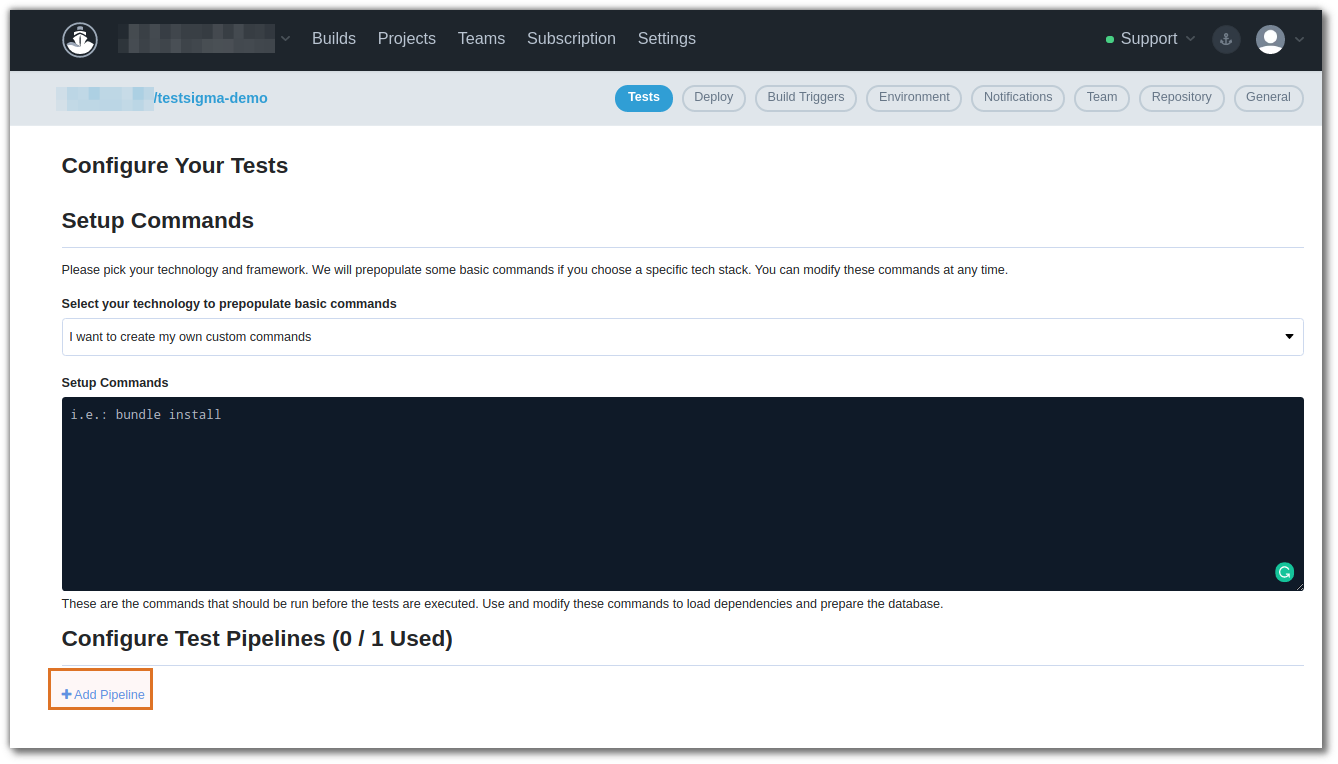
-
In Setup Commands, enter the below command to install jq package:
'sudo apt-get install jq'
'Info: jq is json query parser library for bash'
- Click on Add Pipeline and enter a name for the pipeline. We will be entering Testsigma Execution Trigger.
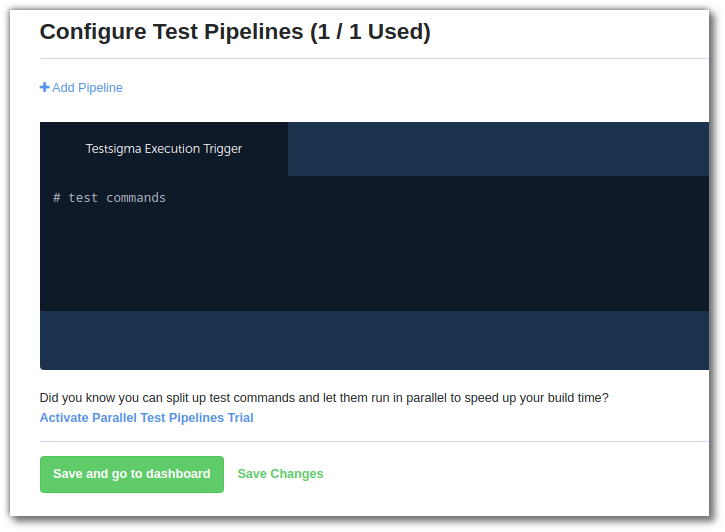
- Go to the Testsigma Executions page to get the Execution ID and CI Webhook URL as shown below:
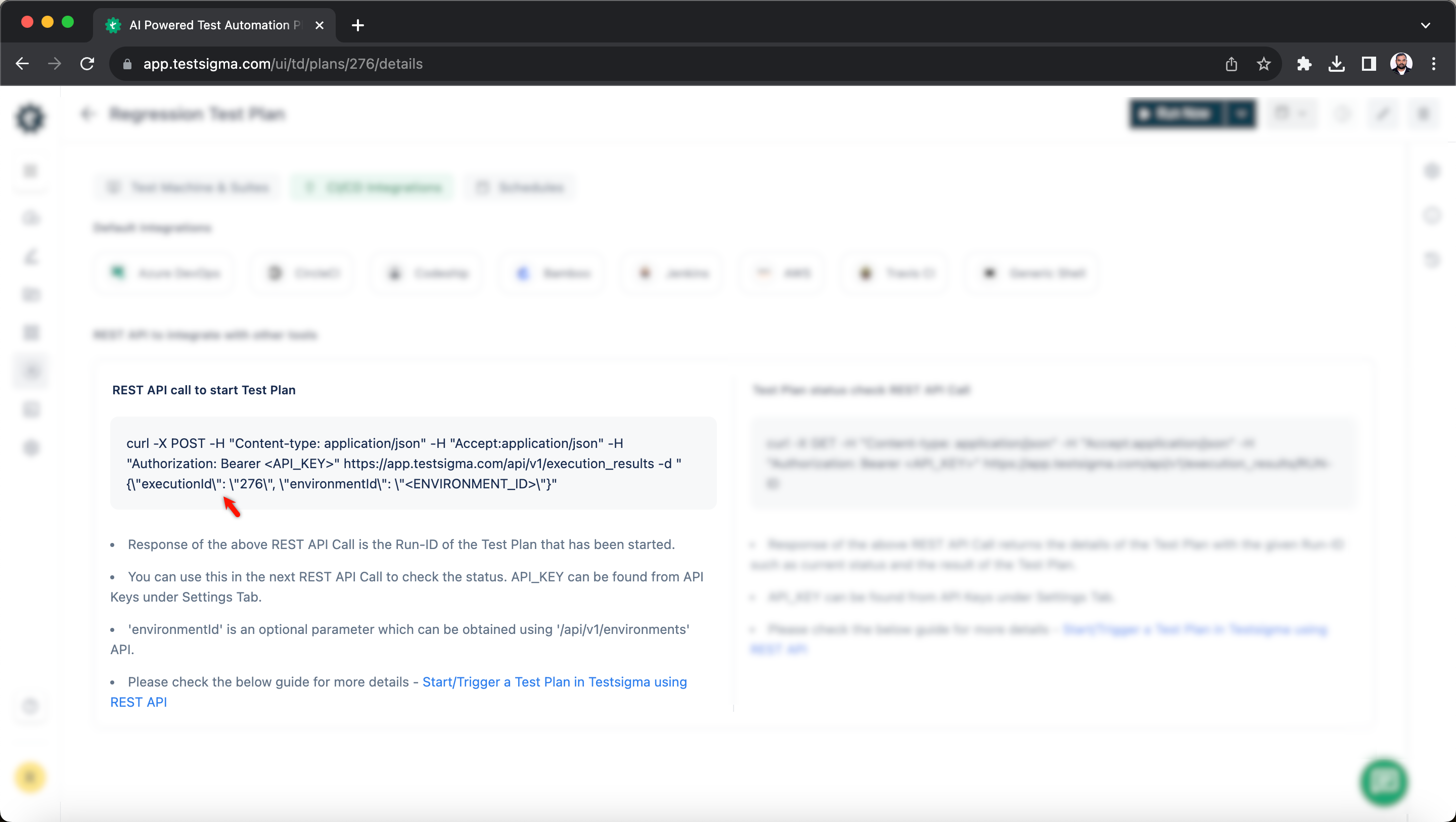
- Replace the <execution-ID>, <Username> and <Password> in the following script:
Perl
#!/bin/bash
echo "Triggering Execution!"
# Triggering an execution using the <Execution-ID> from Testsigma Execution details page. Use your account login details as <Username> and <Password>
currentrunid=$(curl -sS -X POST -H 'Content-type: application/json' -u <Username:<Password> https://app.testsigma.com/rest/execution/<Execution-ID>/run)
echo "Started Execution. Waiting for tests to complete..."
currentstatus=1
#Use the Execution Status Check API and loop until the value of 'status' in the API Response equals to 0.
while [ $currentstatus -ne 0 ]; do currentstatus=$(curl -sS -X GET -H 'Content-type: application/json' -u <Username:<Password> https://app.testsigma.com/rest/execution/<Execution-ID>/run/$currentrunid/status | jq '.status'); sleep 5; done
echo "Test Execution Completed. Checking results..."
#Get the value of 'result' from the API Response for Execution Status Check API
currentresult=$(curl -sS -X GET -H 'Content-type: application/json' -u <Username:<Password> https://app.testsigma.com/rest/execution/<Execution-ID>/run/$currentrunid/status | jq '.result')
echo $currentresult
#Check the result of the execution using Execution Status Check API - If the value of 'result' is 0, the test passed. Else, the test failed.
if [ $currentresult -ne 0 ]; then echo "Test Failed. Please check Testsigma to know the reason for failure."; else echo "Test Passed! You may deploy now!"; fi
#Return the result as exit code - Non-zero value for execution result depicts Test failure and also triggers this script failure.
$(exit $currentresult)- Paste the script in the new test commands box as shown below and click on the Save and go to Dashboard button.
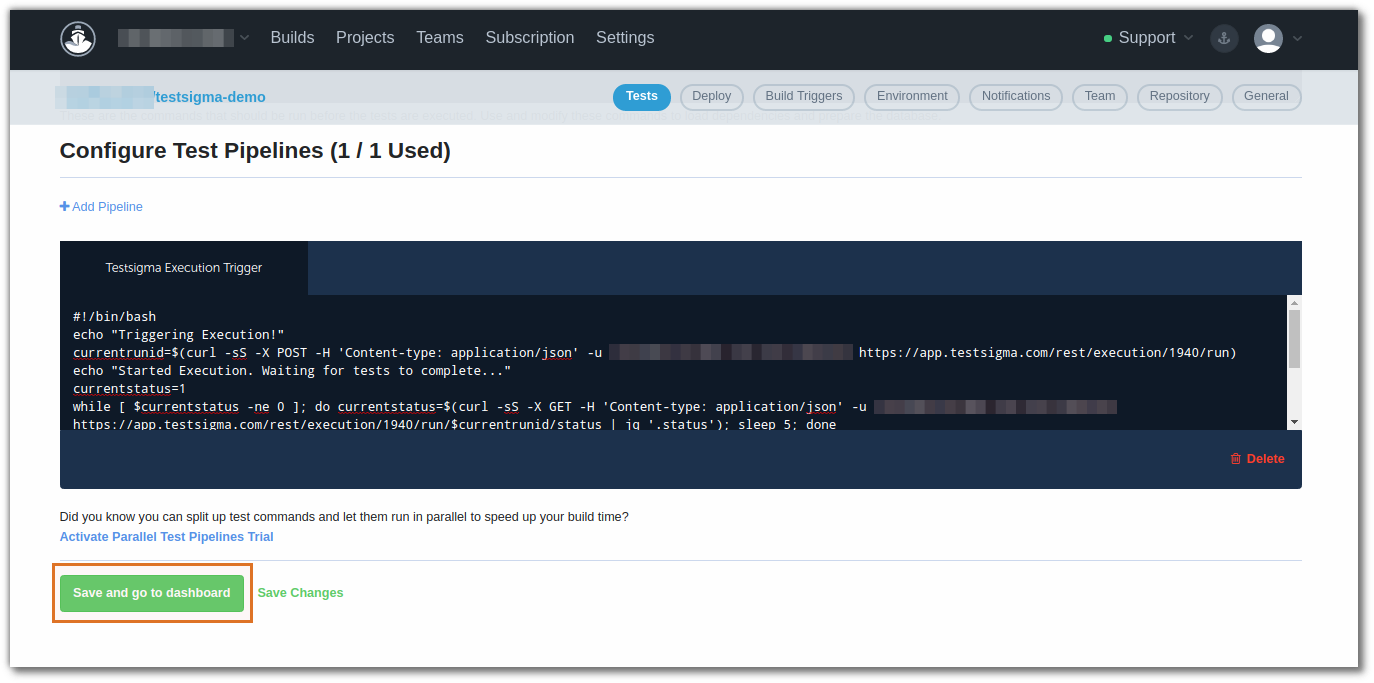
- Now go to the Project Settings > Build Trigger to add a build Trigger.
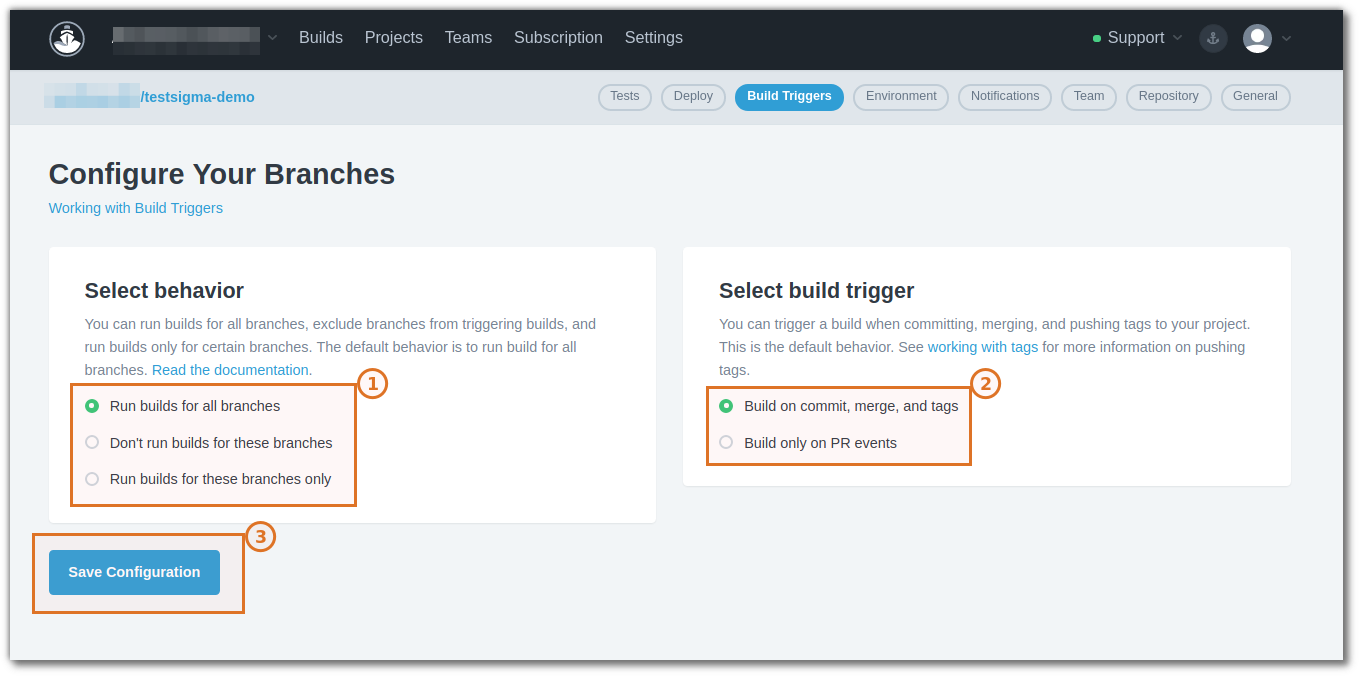
- Optional - You may also go to Project Settings > Deploy to add details of your deployment platform.
That's all we need to do to trigger the Testsigma Executions in the CodeShip Pipeline. With the above settings, the build will be triggered whenever there is a change in the repository and as soon as the build is triggered, the tests will begin in Testsigma. The script will wait until the test completes and checks that the result of the tests is passed.